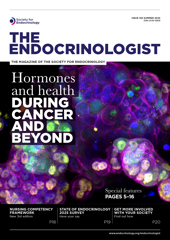GUT MICROBIOTA AND COLONIC ENTEROENDOCRINE CELL INTERACTION REGULATES HOST METABOLISM
|
Hot topics
Body weight regulation relies on complex neurohormonal mechanisms, with the enteroendocrine cells (EECs) of the intestine playing a central role. These specialised cells produce over 20 peptide hormones and can sense small molecules in the gut lumen as well as circulating metabolites and hormones. Research has largely focused on EECs in the proximal gastrointestinal tract, while the role of colonic EECs has been overlooked, partly due to the belief that the colon has a limited metabolic role, while mainly supporting water and electrolyte absorption. However, new insights into the colon’s microbiota reveal its important role in fermenting non-digestible nutrients.
Tan and colleagues explored the role of colonic EECs in metabolism by developing a mouse model with EEC deficiency. They observed that the EEC-deficient mice developed hyperphagia and obesity. Experiments indicated that EEC deficiency alters microbiota composition and metabolism. Stool and blood metabolome analyses revealed that differential glutamate production by gut microbiota was linked to increased appetite. Additionally, direct colonic administration of glutamate was shown to boost food intake.
These findings reveal a previously unknown connection between the host and microbiota in the colon, which plays a role in the gut–brain axis that controls metabolism and body weight.
Read the full article in Nature Metabolism 6 1076–1091 https://doi.org/10.1038/s42255-024-01044-5





